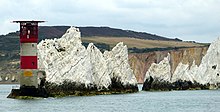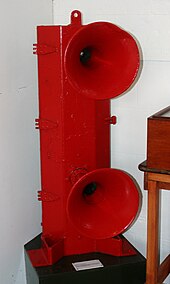Lighthouse
 Aerial view of Needles Lighthouse Aerial view of Needles Lighthouse | |
| Location | Alum Bay Isle of Wight England |
|---|---|
| OS grid | SZ2895484811 |
| Coordinates | 50°39′44.2″N 1°35′30.5″W / 50.662278°N 1.591806°W / 50.662278; -1.591806 |
| Tower | |
| Constructed | 1786 (first) |
| Built by | James Walker |
| Construction | granite tower |
| Automated | 1994 |
| Height | 31 m (102 ft) |
| Shape | cylindrical tower with lantern and helipad above lantern |
| Markings | tower with red and white bands |
| Operator | Trinity House |
| Heritage | Grade II listed building |
| Fog signal | two blasts every 30s. |
| Light | |
| First lit | 1859 (current) |
| Focal height | 24 m (79 ft) |
| Lens | 2nd order 700mm fixed lens |
| Intensity | white: 12,300 candela red (intensified): 3,950 candela red: 1,800 candela green 2,860 candela |
| Range | white and red (intensified): 17 nmi (31 km; 20 mi) red and green: 14 nmi (26 km; 16 mi) |
| Characteristic | Oc (2) WRG 20s. |
The Needles Lighthouse is an active 19th century lighthouse on the outermost of the chalk rocks at The Needles on the Isle of Wight in the United Kingdom, near sea level. Designed by James Walker, for Trinity House at a cost of £20,000, it was completed in 1859 from granite blocks. It stands 33.25 metres (109.1 ft) high and is a circular tower with straight sides. It replaced an earlier light tower on top of a cliff overhanging Scratchell's Bay, which was first lit on 29 September 1786.
The first lighthouse
In 1781 a group of merchants and ship owners petitioned Trinity House for navigation lights to be provided around the western approaches to the Solent. The response was positive, but it was not until 1785 that construction began, on three new lighthouses: one on the clifftop above the Needles, one on Hurst Point and one on St Catherine's Down (which was left unfinished and never lit); all three were designed by Richard Jupp.
From September the following year the Needles light was operational. It was described as 'a low truncated cone, situated on the highest point of the lofty cliffs , and near the edge of the cliff, forming the western extremity of the island'; however, its height of 496 feet (151 m) above sea level meant it was often obscured by fog and sea mists, a problem that eventually led to its replacement some 70 years later. Illumination was provided by 13 Argand lamps with parabolic reflectors; The light initially shone white, but on 1 March 1840 it was altered to display a red light, so as not to be confused with the newly erected lighthouse on St Catherine's Point. Prior to its decommissioning, the light shone red to seaward but white from St Alban's Head to Hurst Point.
The current lighthouse
History

Before work could begin on the new tower, a sizeable section of rock was cut away to provide a level base. Tunnels were also excavated within the rock behind the tower to provide rooms for storage. An oil burner, with four concentric wicks, provided the light source atop the new tower; it was set within a large (first-order) fixed catadioptric optic provided by Henry-Lepaute of Paris. Keepers' accommodation was provided within the lighthouse, which was to be staffed by a team of three keepers (of whom, at any one time, two would be on duty in the tower and one on shore leave, by monthly rotation).
The lighthouse was first lit on 1 January 1859. It initially displayed a fixed red light with a white sector indicating a clear approach running south of Durlestone Head and past a pair of sandbanks: South-west Shingles and Dolphin Bank. Later a narrow white sector marked the approach from the north-east past Warden Ledge; By 1884 a further (green) sector had been added and the light made occulting.
The tower itself had initially been left as plain granite 'not coated nor coloured', but in 1886, so as to make it stand out more prominently against the cliffs during the day, it was painted with a broad black stripe around the middle; the metalwork of the lantern was also painted black, and dark curtains were hung within the glass when the lamp was not in use.
In 1922, a more powerful incandescent paraffin vapour burner was installed, which increased the intensity of the light from 35,000 to 500,000 candlepower.
During the Second World War, the lantern, lens and lamp were badly damaged in a German aerial attack. After the war the lighthouse was repaired: in 1946, a new electric light was installed (powered by diesel generators providing 100 volt direct current); then, in 1948, a new, second-order fixed catadioptric optic was made for the lighthouse by Chance Brothers, to replace the one damaged in the war.

Before automation, the lighthouse was staffed by a three-man crew operating a 24-hour watch, serving one month on / one month off, living in rudimentary conditions in three levels below the light. In 1987, a helipad was added to the top of the lighthouse. By the early 1990s the Needles was the last Trinity House lighthouse to be powered by 100 V DC electricity from its own generators. Before it could become fully automated, a submarine power cable had to be laid, bringing 240 V mains electricity to the lighthouse from the island. By the time the last keepers left on 8 December 1994 the Needles was one of the last three remaining manned rock lighthouses in England and Wales.
Fog signalling apparatus

Initially the lighthouse had been provided with a 3 cwt bell, hung beneath the gallery, to serve as a fog signal. The bell was struck once every 7.5 seconds; it was sounded by a clockwork mechanism, but using it was 'an arduous piece of work, for the driving weights are very heavy and need to be frequently wound up'.
In 1906, a reed fog signal was installed, together with a pair of oil engines in the basement of the tower to provide compressed air; it sounded from three acoustic horns which protruded through the roof of the lantern, giving one long blast every fifteen seconds. In 1946, as part of the electrification of the light, Gardner diesel-driven generators replaced the oil engines; these also powered compressors for the fog horn, which were installed along with a set of air tanks just below the lantern room.
By 1964, the reeds had been replaced with two sets of 'supertyfon' air horns, mounted on the parapet surrounding the lantern, which sounded twice every 30 seconds. In 1994, these were in turn replaced by electric emitters as part of the automation process.
Present day
Today the main lamp is a 1500W bulb; the fixed optic with its coloured sectors remains in use as of 2019. Due to the condition of the chalk strata on which the lighthouse was built, in April 2010 a £500,000 underpinning project was announced, designed to stop the lighthouse falling into the sea. Over a 12-week period from early June, civil marine contractors Nuttall John Martin excavated a trench around the base of the lighthouse, to install a ring of stabilising posts, reinforced with concrete.
See also
References
- Rowlett, Russ. "Lighthouses of Southern England". The Lighthouse Directory. University of North Carolina at Chapel Hill. Retrieved 3 May 2016.
- Needles Lighthouse Trinity House. Retrieved 3 May 2016
- ^ "Needles Lighthouse". Trinity House. n.d. Archived from the original on 2 May 2010. Retrieved 25 May 2010.
- Brettell, Thomas (1844). Handbook to the Isle of Wight (3rd ed.). London: John Mitchell.
- ^ "Lighthouse management : the report of the Royal Commissioners on Lights, Buoys, and Beacons, 1861, examined and refuted Vol. 2". p. 82.
- London Gazette, Issue 19821, Page 243, 7 February 1840
- ^ Hobbs, J. S. (1859). The Bristol Channel Pilot: from The Downs to Bristol. London: Charles Wilson. p. 36.
- The English Channel Pilot. London: Charles Wilson. 1878. p. 54.
- Edwards, E. Price (1884). Our Seamarks: a plain account of the Lighthouses, Lightships, Beacons, Buoys, and Fog-signals maintained on our Coasts. London: Longmans, Green & co. p. 184. Retrieved 25 February 2019.
- London Gazette, Issue 25564, Page 1035, 2 March 1886
- "Needles Light To Be Made More Powerful". The Nautical Gazette. 103 (11): 340. 9 September 1922.
- "By Chance". Magazine of the Future. III (2): 27. March 1948.
- Nowicka, Helen (15 August 1993). "Last one out, leave the light on: The Needles lighthouse is to lose its keepers as manning is phased out around Britain". The Independent. London. Archived from the original on 7 November 2012. Retrieved 25 May 2010.
- Potter, J. D. (1900). The Channel Pilot, Part 1. London: Hydrographic Department. p. 206.
- "Lighthouse Life". The London Magazine. VII (42): 537. January 1902.
- ^ Renton, Alan (2001). Lost Sounds: The Story of Coast Fog Signals. Caithness, Scotland: Whittles.
- British Islands Pilot, volume I (2nd ed.). Washington DC: Government Printing Office. 1920. p. 240.
- Admiralty Chart, corrected up to 1964.
- Whitehead, John D.; Edwards, Marie. "St Catherine's Point". Wight Life.
- Needles Lighthouse Trinity House. Retrieved 1 May 2019
- "Rescue to save Needles lighthouse landmark". The Mirror. 30 April 2010. Archived from the original on 20 November 2011. Retrieved 25 May 2010.
- "Work to start on crumbling lighthouse". Isle of Wight County Press. 28 April 2010. Archived from the original on 1 May 2010. Retrieved 25 May 2010.
External links
- Trinity House
- Needles Lighthouse Solar Powered Web Camera
- Photo 1, Photo 2 and Photo 3, showing the pre-war optic, vapour burner and occulting mechanism in 1938.
- Photo showing the pre-war oil engines/compressors for the fog signal.
- Photo, 1938, showing the reed fog horns.
- Photo of the tower, 1970, showing the 'supertyfon' horns.